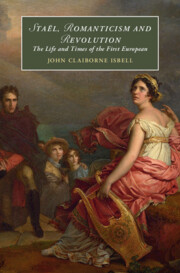Book contents
- Staël, Romanticism and Revolution
- Cambridge Studies in Romanticism
- Staël, Romanticism and Revolution
- Copyright page
- Epigraph
- Contents
- Preface
- Acknowledgments
- Abbreviations
- Introduction
- Chapter 1 The Painful Birth of the Romantic Heroine
- Chapter 2 Revolution and the Private Sphere
- Chapter 3 Madame de Staël, Minister for War?
- Chapter 4 The Social Contract for Staël and Constant, or Does Liberty Have a Sex?
- Chapter 5 When the Light of Reason Fails
- Chapter 6 Imaginary Europe
- Chapter 7 Suicide, Meaning, and Power in the Querelle of Delphine
- Chapter 8 My Father, Myself
- Chapter 9 Italy, or Corinne
- Chapter 10 Interlude
- Chapter 11 Napoleon Pulps His Enemies
- Chapter 12 The Napoleon Apocalypse
- Chapter 13 Romantic Spain and National Resistance
- Chapter 14 A. W. Schlegel, Staël, and Sismondi in 1814
- Chapter 15 The Italian Romantics and Madame de Staël
- Chapter 16 Inventing the French Revolution
- Chapter 17 Voices Lost?
- Conclusion
- Notes
- Select Bibliography
- Index
- Cambridge Studies in Romanticism
Chapter 6 - Imaginary Europe
De la littérature considérée dans ses rapports avec les institutions sociales, 1800
Published online by Cambridge University Press: 03 August 2023
- Staël, Romanticism and Revolution
- Cambridge Studies in Romanticism
- Staël, Romanticism and Revolution
- Copyright page
- Epigraph
- Contents
- Preface
- Acknowledgments
- Abbreviations
- Introduction
- Chapter 1 The Painful Birth of the Romantic Heroine
- Chapter 2 Revolution and the Private Sphere
- Chapter 3 Madame de Staël, Minister for War?
- Chapter 4 The Social Contract for Staël and Constant, or Does Liberty Have a Sex?
- Chapter 5 When the Light of Reason Fails
- Chapter 6 Imaginary Europe
- Chapter 7 Suicide, Meaning, and Power in the Querelle of Delphine
- Chapter 8 My Father, Myself
- Chapter 9 Italy, or Corinne
- Chapter 10 Interlude
- Chapter 11 Napoleon Pulps His Enemies
- Chapter 12 The Napoleon Apocalypse
- Chapter 13 Romantic Spain and National Resistance
- Chapter 14 A. W. Schlegel, Staël, and Sismondi in 1814
- Chapter 15 The Italian Romantics and Madame de Staël
- Chapter 16 Inventing the French Revolution
- Chapter 17 Voices Lost?
- Conclusion
- Notes
- Select Bibliography
- Index
- Cambridge Studies in Romanticism
Summary
Chapter 6 reviews De la littérature. When Staël published this work, she had spent the previous decade growing older alongside the French Revolution, but the coup of 18 Brumaire had just ushered in the Consulat: Napoleon’s star was on the rise. This was not the most obvious time for an ex-minister for war to become a literary historian. Why then did Staël choose this juncture to write and publish her 400-page tractatus? Though we could descend into the weeds of Staël’s many literary details, we would there risk succumbing to a range of propagandist forces. Genevan, liberal, female, and Protestant, Staël has faced two centuries of critics eager to sideline or indeed privatize her achievements, presenting them as tangential to the public shaping of what it means to be French. This chapter argues that Staël’s 1800 work is engagé and focused on saving the Revolution if not the Republic.
- Type
- Chapter
- Information
- Staël, Romanticism and RevolutionThe Life and Times of the First European, pp. 58 - 67Publisher: Cambridge University PressPrint publication year: 2023

